[English] 日本語
 Yorodumi
Yorodumi- PDB-6tuq: Cryo-EM structure of Pf4 bacteriophage coat protein without ssDNA -
+ Open data
Open data
- Basic information
Basic information
| Entry | Database: PDB / ID: 6tuq | ||||||
|---|---|---|---|---|---|---|---|
| Title | Cryo-EM structure of Pf4 bacteriophage coat protein without ssDNA | ||||||
 Components Components | Coat protein B of bacteriophage Pf1 | ||||||
 Keywords Keywords | VIRUS / Bacteriophage / helical / filamentous | ||||||
| Function / homology | Inovirus Coat protein B / Capsid protein G8P / helical viral capsid / host cell membrane / membrane / Capsid protein G8P / Coat protein B of bacteriophage Pf1 Function and homology information Function and homology information | ||||||
| Biological species |  Pseudomonas virus Pf1 Pseudomonas virus Pf1 | ||||||
| Method | ELECTRON MICROSCOPY / helical reconstruction / cryo EM / Resolution: 3.9 Å | ||||||
 Authors Authors | Tarafder, A.K. / von Kugelgen, A. / Bharat, T.A.M. | ||||||
| Funding support |  United Kingdom, 1items United Kingdom, 1items
| ||||||
 Citation Citation |  Journal: Proc Natl Acad Sci U S A / Year: 2020 Journal: Proc Natl Acad Sci U S A / Year: 2020Title: Phage liquid crystalline droplets form occlusive sheaths that encapsulate and protect infectious rod-shaped bacteria. Authors: Abul K Tarafder / Andriko von Kügelgen / Adam J Mellul / Ulrike Schulze / Dirk G A L Aarts / Tanmay A M Bharat /  Abstract: The opportunistic pathogen is a major cause of antibiotic-tolerant infections in humans. evades antibiotics in bacterial biofilms by up-regulating expression of a symbiotic filamentous inoviral ...The opportunistic pathogen is a major cause of antibiotic-tolerant infections in humans. evades antibiotics in bacterial biofilms by up-regulating expression of a symbiotic filamentous inoviral prophage, Pf4. We investigated the mechanism of phage-mediated antibiotic tolerance using biochemical reconstitution combined with structural biology and high-resolution cellular imaging. We resolved electron cryomicroscopy atomic structures of Pf4 with and without its linear single-stranded DNA genome, and studied Pf4 assembly into liquid crystalline droplets using optical microscopy and electron cryotomography. By biochemically replicating conditions necessary for antibiotic protection, we found that phage liquid crystalline droplets form phase-separated occlusive compartments around rod-shaped bacteria leading to increased bacterial survival. Encapsulation by these compartments was observed even when inanimate colloidal rods were used to mimic rod-shaped bacteria, suggesting that shape and size complementarity profoundly influences the process. Filamentous inoviruses are pervasive across prokaryotes, and in particular, several Gram-negative bacterial pathogens including , and harbor these prophages. We propose that biophysical occlusion mediated by secreted filamentous molecules such as Pf4 may be a general strategy of bacterial survival in harsh environments. | ||||||
| History |
|
- Structure visualization
Structure visualization
| Movie |
 Movie viewer Movie viewer |
|---|---|
| Structure viewer | Molecule:  Molmil Molmil Jmol/JSmol Jmol/JSmol |
- Downloads & links
Downloads & links
- Download
Download
| PDBx/mmCIF format |  6tuq.cif.gz 6tuq.cif.gz | 21.3 KB | Display |  PDBx/mmCIF format PDBx/mmCIF format |
|---|---|---|---|---|
| PDB format |  pdb6tuq.ent.gz pdb6tuq.ent.gz | 11.8 KB | Display |  PDB format PDB format |
| PDBx/mmJSON format |  6tuq.json.gz 6tuq.json.gz | Tree view |  PDBx/mmJSON format PDBx/mmJSON format | |
| Others |  Other downloads Other downloads |
-Validation report
| Summary document |  6tuq_validation.pdf.gz 6tuq_validation.pdf.gz | 735.6 KB | Display |  wwPDB validaton report wwPDB validaton report |
|---|---|---|---|---|
| Full document |  6tuq_full_validation.pdf.gz 6tuq_full_validation.pdf.gz | 735 KB | Display | |
| Data in XML |  6tuq_validation.xml.gz 6tuq_validation.xml.gz | 10.4 KB | Display | |
| Data in CIF |  6tuq_validation.cif.gz 6tuq_validation.cif.gz | 13.1 KB | Display | |
| Arichive directory |  https://data.pdbj.org/pub/pdb/validation_reports/tu/6tuq https://data.pdbj.org/pub/pdb/validation_reports/tu/6tuq ftp://data.pdbj.org/pub/pdb/validation_reports/tu/6tuq ftp://data.pdbj.org/pub/pdb/validation_reports/tu/6tuq | HTTPS FTP |
-Related structure data
| Related structure data |  10594MC  6tupC C: citing same article ( M: map data used to model this data |
|---|---|
| Similar structure data |
- Links
Links
- Assembly
Assembly
| Deposited unit | 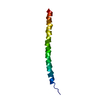
|
|---|---|
| 1 | x 50
|
- Components
Components
| #1: Protein/peptide | Mass: 4612.393 Da / Num. of mol.: 1 / Source method: isolated from a natural source / Source: (natural)  Pseudomonas virus Pf1 / References: UniProt: Q9I5K5, UniProt: P03621*PLUS Pseudomonas virus Pf1 / References: UniProt: Q9I5K5, UniProt: P03621*PLUS |
|---|
-Experimental details
-Experiment
| Experiment | Method: ELECTRON MICROSCOPY |
|---|---|
| EM experiment | Aggregation state: FILAMENT / 3D reconstruction method: helical reconstruction |
- Sample preparation
Sample preparation
| Component | Name: Pseudomonas virus Pf1 / Type: VIRUS / Entity ID: all / Source: NATURAL | |||||||||||||||||||||||||
|---|---|---|---|---|---|---|---|---|---|---|---|---|---|---|---|---|---|---|---|---|---|---|---|---|---|---|
| Molecular weight | Experimental value: NO | |||||||||||||||||||||||||
| Source (natural) | Organism:  Pseudomonas virus Pf1 Pseudomonas virus Pf1 | |||||||||||||||||||||||||
| Details of virus | Empty: YES / Enveloped: NO / Isolate: STRAIN / Type: VIRION | |||||||||||||||||||||||||
| Natural host | Organism: Pseudomonas aeruginosa (strain ATCC 15692 / DSM 22644 / CIP 104116 / JCM 14847 / LMG 12228 / 1C / PRS 101 / PAO1) | |||||||||||||||||||||||||
| Virus shell | Name: Coat protein B (CoaB) / Diameter: 62 nm | |||||||||||||||||||||||||
| Buffer solution | pH: 7.4 / Details: 1x Phosphate buffered saline | |||||||||||||||||||||||||
| Buffer component |
| |||||||||||||||||||||||||
| Specimen | Conc.: 5 mg/ml / Embedding applied: NO / Shadowing applied: NO / Staining applied: NO / Vitrification applied: YES | |||||||||||||||||||||||||
| Specimen support | Details: 20 second glow discharge at 15 mA in a LeicaEM ACE200 Grid material: COPPER/RHODIUM / Grid mesh size: 200 divisions/in. / Grid type: Quantifoil R2/2 | |||||||||||||||||||||||||
| Vitrification | Instrument: FEI VITROBOT MARK IV / Cryogen name: ETHANE / Humidity: 100 % / Chamber temperature: 283 K Details: Samples for cryo-EM were prepared by pipetting 2.5 ul of the sample onto freshly glow-discharged Quantifoil grids (Cu/Rh R2/2, 200 mesh). Grids were blotted for 2.5 seconds with a blot force ...Details: Samples for cryo-EM were prepared by pipetting 2.5 ul of the sample onto freshly glow-discharged Quantifoil grids (Cu/Rh R2/2, 200 mesh). Grids were blotted for 2.5 seconds with a blot force of -15, 0.5 second drain and 0 second wait times. |
- Electron microscopy imaging
Electron microscopy imaging
| Experimental equipment |  Model: Titan Krios / Image courtesy: FEI Company |
|---|---|
| Microscopy | Model: FEI TITAN KRIOS |
| Electron gun | Electron source:  FIELD EMISSION GUN / Accelerating voltage: 300 kV / Illumination mode: FLOOD BEAM FIELD EMISSION GUN / Accelerating voltage: 300 kV / Illumination mode: FLOOD BEAM |
| Electron lens | Mode: BRIGHT FIELD / Nominal magnification: 105000 X / Calibrated magnification: 105000 X / Nominal defocus max: -3000 nm / Nominal defocus min: -1000 nm / Calibrated defocus min: -1000 nm / Calibrated defocus max: -3000 nm / Cs: 2.7 mm / C2 aperture diameter: 50 µm / Alignment procedure: ZEMLIN TABLEAU |
| Specimen holder | Cryogen: NITROGEN / Specimen holder model: FEI TITAN KRIOS AUTOGRID HOLDER / Temperature (max): 80 K / Temperature (min): 80 K |
| Image recording | Average exposure time: 10 sec. / Electron dose: 43 e/Å2 / Detector mode: COUNTING / Film or detector model: GATAN K2 SUMMIT (4k x 4k) / Num. of grids imaged: 2 / Num. of real images: 4110 |
| EM imaging optics | Energyfilter name: GIF Bioquantum / Chromatic aberration corrector: none / Energyfilter slit width: 20 eV / Phase plate: OTHER / Spherical aberration corrector: none |
| Image scans | Movie frames/image: 40 / Used frames/image: 1-40 |
- Processing
Processing
| EM software |
| ||||||||||||||||||||||||||||||||||||||||
|---|---|---|---|---|---|---|---|---|---|---|---|---|---|---|---|---|---|---|---|---|---|---|---|---|---|---|---|---|---|---|---|---|---|---|---|---|---|---|---|---|---|
| CTF correction | Details: Wiener filter implemented in the RELION refinement algorithm Type: PHASE FLIPPING AND AMPLITUDE CORRECTION | ||||||||||||||||||||||||||||||||||||||||
| Helical symmerty | Angular rotation/subunit: 3.14 ° / Axial rise/subunit: 65.9 Å / Axial symmetry: C1 | ||||||||||||||||||||||||||||||||||||||||
| Particle selection | Num. of particles selected: 351381 | ||||||||||||||||||||||||||||||||||||||||
| 3D reconstruction | Resolution: 3.9 Å / Resolution method: FSC 0.143 CUT-OFF / Num. of particles: 95481 / Algorithm: FOURIER SPACE / Num. of class averages: 1 / Symmetry type: HELICAL | ||||||||||||||||||||||||||||||||||||||||
| Atomic model building | B value: 180.97 / Protocol: BACKBONE TRACE / Space: REAL / Target criteria: Correlation coefficient |
 Movie
Movie Controller
Controller



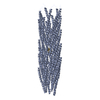

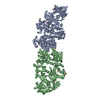

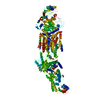
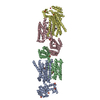
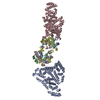
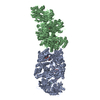
 PDBj
PDBj